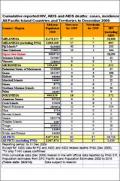What's New
Displaying results 3891 - 3900 of 4914
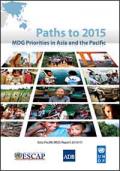
Resource | Publications,
Since 2004, an ESCAP/ADB/UNDP partnership has regularly produced reports carefully tracking progress of the Asia and Pacific region towards the Goals. They have developed a consistent monitoring system for judging whether countries and subregions are on-track or off-track to meet the indicators for the 2015 Goals – presenting the results in a series of distinctive colour-coded ‘traffic-light’ charts. Each of the reports has focused on a particular theme, such as Millennium Development Goals (MDG) consistent national development policies or institutional reforms to make the development process fairer and more inclusive, or the impact of the food, fuel and financial crises on the likely achievement of the goals.
The report Paths to 2015 emphasises the inter-relationships between MDGs by identifying some overall priorities and opportunities that countries can consider for achieving all the goals. Then it focuses specifically on three areas: hunger and food security; health and basic services – areas where the Asia-Pacific region as a whole appears to be falling short; and on improvement of basic infrastructure which is often neglected but is critical if the region is to achieve the MDGs.
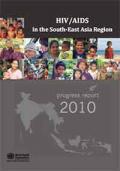
Resource | Publications,
This annual 2010 progress report on "HIV/AIDS in the South-East Asia Region" presents key achievements in prevention and control of HIV in the Region and highlights areas where further work is needed.
The Region is home to nearly 3.5 million people living with HIV/AIDS of whom nearly half are likely to be co-infected with TB. A large number of new HIV infections are still occurring each year which places HIV prevention at the top of the agenda for national AIDS programmes.
Overall, good progress has been made in reducing heterosexual transmission of HIV through 100% condom use programmes and community-based peer led interventions. There has also been noteworthy success in ensuring safe blood transfusion services averting hundreds of thousands of infections every year. Just a few years ago, access to treatment was a dream for most people living with HIV in the Region. Today, more than half a million people living with HIV in the South-East Asia Region are on treatment, living longer and contributing to society.
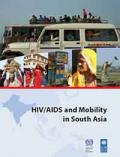
Resource | Publications,
For the millions who seek greater employment and economic opportunities migration is an increasingly attractive option. Migrants not only comprise an essential component of the workforce in more economically developed countries, but also provide significant contributions to the national economies of their home countries.
Migrants, however, are often exploited, marginalized, and stigmatized throughout the migration process. As mobility within South Asian countries and migration within the region and abroad continues to grow, care must be made to ensure that migrants’ rights are protected.
This study provides a synthesis of current migration trends and the HIV situation in seven countries of South Asia, examining the HIV situation of migrants within the context of gender, national and international migration patterns, policies and legislation. It is our hope that it provides a comprehensive reference tool for future policy, programmes and advocacy, and ultimately, contributes to the protection of migrants’ rights throughout the whole migration cycle.
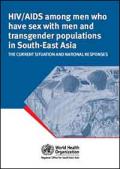
Resource | Publications,
In 2009, a situation assessment was conducted among men who have sex with men (MSM) and transgender (TG) populations in South-East Asia. The aim was to improve our understanding of HIV and sexually transmitted infections (STI), the risk behaviours, as well as the nature and extent of the national responses to the HIV epidemics among these populations. The data collected and analysed will inform current and future action in the South-East Asia Region (SEAR) to address the health needs of MSM and TG populations. This desk-based assessment used multiple data sources to review the situation in nine countries of SEAR – Bangladesh, India, Indonesia, Maldives, Myanmar, Nepal, Sri Lanka, Thailand and Timor-Leste.

Resource | Publications,
Data is available for new diagnoses of Human Immunodeficiency Virus (HIV) infections from all Pacific Island Countries and Territories (PICTs) except Papua New Guinea (PNG) for the year to December 2009 and to December 2008 for PNG, Australia and New Zealand. In 2008, there were 5,169 new HIV diagnoses reported in Pacific Island Countries and Territories (PICTs), and diagnoses in PNG accounted for 5,084 or 98.4% of notifications. Excluding PNG, the annual number of new HIV diagnoses reported in PICTs was 85 cases in 2008 and 82 in 2009.

Resource | Publications,
Cumulative reported HIV, AIDS and AIDS deaths: cases, incidence rates and gender, plus cases with missing details; All Pacific Island Countries and Territories to December 2009

Resource | Publications,
In recent years the Asia-Pacific region, along with the rest of the world, has been assailed by a series of global crises, first the energy and food crises, and more recently the financial and economic crisis – all of which have presented threats to development and to the achievement of the Millennium Development Goals (MDGs).
This report assesses the likely impact. First it tracks progress towards the Goals on the basis of data collected prior to the economic crisis on 21 out of the 60 official MDG indicators. Then it considers how this progress might be hindered by recent events. Drawing from the lessons of the crisis, the report also explores measures to make regional economies more socially resilient to economic cycles.
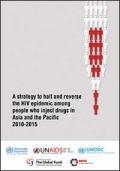
Resource | Publications,
The present document, "A Strategy to Halt and Reverse the HIV Epidemic among People Who Inject Drugs in Asia and the Pacific, 2010–2015" can be a crucial tool. It is a call to action and a road map to ensure that the HIV and hepatitis epidemics among people who use drugs and their sexual partners in the Asia Pacific region will be halted. The strategy is designed to provide a regional framework, and it identifies issues and priorities and provides guidance to countries in the region for developing national strategic responses over the next six years. It shows the important link between halting the HIV epidemic and health and development, and will help countries achieve United Nations Millennium Development Goal 6 that calls for a halt and a reverse in the spread of HIV by 2015.
The strategy reinforces the need for expansion of needle and syringe programmes, wide availability of opioid substitution therapy (methadone and buprenorphine) and universal access to antiretroviral therapy. All of this must occur on a scale that can impact the epidemic.
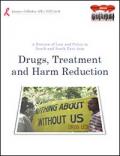
Resource | Publications,
This paper is meant to provide a preview of law and policy on drug use and HIV in South and South East Asia, as it relates to interventions with people who use drugs. Besides cataloguing provisions relevant to people who use drugs and the availability of services for them, the paper flags concerns vis-à-vis health and rights of people using drugs that require further research and analysis. At the Consultation, the paper is expected to facilitate policy debate and advocacy with Parliamentarians. The country section summarizes specific legal and policy provisions that affect people using drugs in 15 Asian countries.
Based on the country findings, the paper then discusses broader implications and challenges for health, harm reduction and human rights in Asia.






